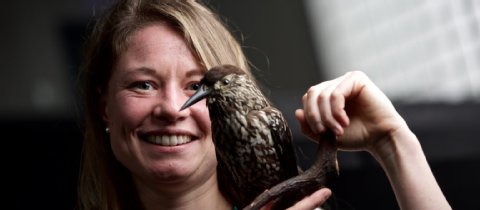
Scientists in Europe this week announced the key result from a synthesis of 408 studies from 34 countries around the globe (July 20, 2016). Not surprisingly, it shows that human activities negatively affect the pollination and seed dispersal of forest trees. The effect can be observed in both tropical and temperate forests and suggests that protecting animal pollinators and seed dispersers could have a positive effect in maintaining forests’ ability to regenerate naturally.
Most at risk, these scientists said, are large-seeded trees whose dispersal depends on large and often endangered animals. An example of a large-seeded tree would be the horse-chestnut (Aesculus hippocastanum) of southeastern Europe.
Eike Lena Neuschulz from the Senckenberg Biodiversity and Climate Research Center in Germany is lead author of the new study. Her team looked at the cycle of plant regeneration in forests, specifically asking how much each part of the cycle is affected by humans. Their statement explained:
To assess the effects of humans, [we] compared near-natural forests with those exposed to intensive human disturbance. The regeneration cycle of plants includes processes that are beneficial to plants, such as pollination, seed dispersal and the recruitment of seedlings, as well as detrimental processes, such as seed predation and herbivory.
In the early stages of plant regeneration, plants benefit from the interaction with animals: bees pollinate flowers and maintain gene flow among plant populations, while birds disperse seeds that can establish as seedlings at new locations.
However, land use changes, hunting and overexploitation of forests threaten these animals, and thereby also their contribution toward forest regeneration.
In contrast, the later processes of plant regeneration such as seed predation, recruitment and herbivory, were found to be less consistently affected by humans. Selective logging, for example, can increase the amount of light reaching the forest floor, but can also dry out the soil, which may facilitate the recruitment of some plants or inhibit that of others.
Neuschutz concluded:
Our study shows that human disturbance negatively affects the early steps of the plant regeneration cycle, while the effects on the later regeneration processes vary greatly.
Our findings suggest that conservation efforts should prioritize the protection of animal pollinators and seed dispersers to maintain the regeneration potential of forest ecosystems in the future.

Bottom line: A synthesis of 408 studies from 34 countries around the globe suggests that humans can help maintain healthy forests by focusing conservation efforts on the protection of animal pollinators and seed dispersers.
The 10 largest natural forests in the world, from listdose.com
The 10 most beautiful forests in the world, from 10mosttoday.com











